
The luna moth, also called the American moon moth, is a Nearctic moth in the family Saturniidae, subfamily Saturniinae, a group commonly named the giant silk moths.

Dryocampa rubicunda, the rosy maple moth, is a small North American moth in the family Saturniidae, also known as the great silk moths. It was first described by Johan Christian Fabricius in 1793. The species is known for its wooly body and pink and yellow coloration, which varies from cream or white to bright pink or yellow. Males have bushier antennae than females, which allow them to sense female pheromones for mating.

Cleridae are a family of beetles of the superfamily Cleroidea. They are commonly known as checkered beetles. The family Cleridae has a worldwide distribution, and a variety of habitats and feeding preferences.

The yellow-sided opossum is an opossum species from South America. It is found in Argentina, Brazil and Uruguay. They have grey or black fur on their dorsal side with yellowish fur on the lateral side that continues down to the feet. They are the most mysterious of all the Monodelphis that is found specifically in the Pampean region or Pampa of Argentina. It is suspected to be a once-in-a-lifetime breeder as seen in a three-year observational study of one population in the marshy grasslands of the Pampean region. Maintaining their native grasslands is important for them to keep a stable population. They show sexual dimorphism in overall size: adult males are typically 100-150 g whereas adult females are 30-70 g.

Mimusops zeyheri is a medium-sized evergreen tree belonging to the family Sapotaceae and widely distributed in rocky places from the east coast of southern Africa, inland and northwards to tropical Africa. It is commonly known as the moepel or Transvaal red milkwood. It is closely related to Mimusops obovata and M. caffra, both of which are South African trees.
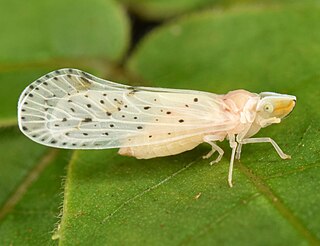
The family Derbidae is a large and diverse group of planthoppers, widely distributed in the tropics and also found in subtropical and temperate regions. It includes more than 150 genera and more than 1500 species. The adults suck the sap of plants while the nymphs live mainly in decaying organic matter, for example under the bark of dead tree trunks, feeding on fungi. In some groups of species the general structure of the insects is largely uniform, whereas in others like in the subfamily Otiocerinae various forms can be found. For example, the shape of the head, the antennae or the wings can differ considerably among genera and species.

Tettigonia viridissima, the great green bush-cricket, is a large species of bush-cricket belonging to the subfamily Tettigoniinae.

Mimusops elengi is a medium-sized evergreen tree found in tropical forests in South Asia, Southeast Asia and northern Australia. English common names include Spanish cherry, medlar, and bullet wood. Its timber is valuable, the fruit is edible, and it is used in traditional medicine. As the trees give thick shade and flowers emit fragrance, it is a prized collection of gardens. It is used as an ornamental tree in many places. The flowers may also be used in natural perfume.

Idaea dimidiata, the single-dotted wave, is a moth of the family Geometridae. It is a Holarctic species.
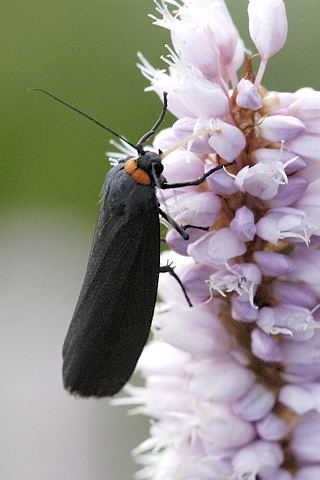
Atolmis rubricollis, the red-necked footman, is a small moth of the family Erebidae. It is found in the summer in forested regions of Europe and Northern Asia. This moth was first described by Carl Linnaeus in his 1758 10th edition of Systema Naturae.

Mimusops afra is a species of tree in family Sapotaceae. This tree is found in coastal dune vegetation in Southern Africa from the Eastern Cape, through KwaZulu-Natal to southern Mozambique.

Aphis gossypii is a tiny insect, an aphid ("greenfly") in the superfamily Aphidoidea in the order Hemiptera. It is a true bug and sucks sap from plants. It is a widely distributed pest of a variety of agricultural crops in the families Cucurbitaceae, Rutaceae and Malvaceae. Common names include cotton aphid, melon aphid and melon and cotton aphid.
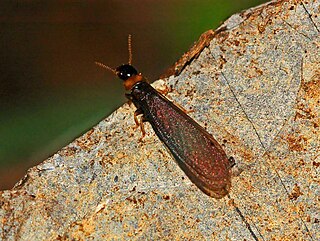
Kalotermes flavicollis, the yellownecked dry-wood termite, is a species of dampwood termites belonging to the family Kalotermitidae, one of the most primitive families of termites.

Manilkara huberi, also known as masaranduba, níspero, and sapotilla, is a fruit bearing plant of the genus Manilkara of the family Sapotaceae.

Banisia myrsusalis, the sapodilla borer or sapota midrib folder, is a species of moth of the family Thyrididae. It was described by Francis Walker in 1859 and is found in North America, Brazil, Australia, southern Asia and Africa.
Myrmecia dimidiata is an Australian ant which belongs to the genus Myrmecia. This species is native to Australia. The Myrmecia dimidiata is distributed in the eastern states of Australia.
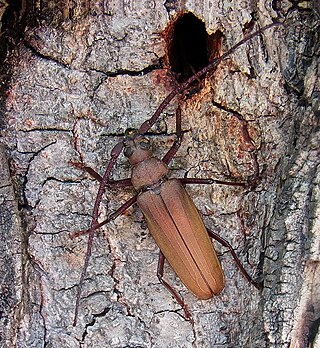
Aegosoma scabricorne is a species of long-horned beetles belonging to the family Cerambycidae.

Grammoptera ruficornis is a species of beetle in family Cerambycidae.

Luperus flavipes is a species of skeletonizing leaf beetle belonging to the family Chrysomelidae, subfamily Galerucinae.
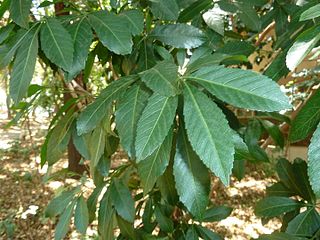
Allophylus natalensis, commonly known as the dune false crowberry or dune false currant, is a species of plant in the genus Allophylus native to south-eastern Africa.



















